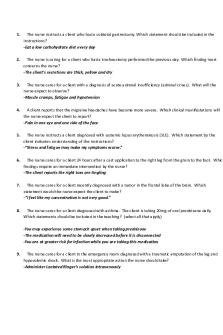Annotated Bibliography 2 med surg PDF

| Title | Annotated Bibliography 2 med surg |
|---|---|
| Author | Taylor Gaia |
| Course | Nursing Medical Surgical Care of Adults 1 |
| Institution | California State University San Marcos |
| Pages | 3 |
| File Size | 88.4 KB |
| File Type | |
| Total Downloads | 62 |
| Total Views | 143 |
Summary
Annotated Bibliography 2 med surgical adult care....
Description
Running head: ANNOTATED BIBLIOGRAPHY 2
Annotated Bibliography 2 Taylor Gaia California State University, Long Beach Summer 2017
1
ANNOTATED BIBLIOGRAPHY 2
2
Mizerek, Elizabeth, & Wolf, Lisa. (2015). To Foley or Not To Foley: Emergency Nurses' Perceptions of Clinical Decision Making in the Use of Urinary Catheters in the Emergency Department. Journal of Emergency Nursing, 41(4), 329-334. Summary: The article’s primary focus was to discuss the decision-making process of catheter placement in the emergency hospital setting. With catheter-associated urinary tract infections accounting for over forty-percent of nosocomial infections in the nation, it is vital for nurses to be able to make appropriate decisions when catheterization is needed. Having the ability to see when catheterization is not needed and when is the soonest it can be removed is crucial for proper patient care. The individual factors that facilitate effective catheter decisions usually revolve around the nurse, not so much the provider in emergency situations. Barriers to proper catheterization appears to be linked to non-consistent protocols between hospitals and even within one hospital alone. Proper sterile techniques used while inserting catheters is one of the most crucial aspects of avoiding catheter-associated urinary tract infections. Recommendations for the future include having staff receive additional courses in education and competency of sterile insertion of catheters; evaluated by visual observation of an instructor. Discrepancies with protocols within the hospital setting cause miscommunication between nurses, patients, and physicians. Proper education of the procedures and clear hospital protocols are the most effective way to prevent catheter-related infections within the hospital. There are several proposed methods on how to improve nursing compliance to sterile techniques. First, protocols and guidelines should be established; secondly, nurses should receive lessons at the hospital in which they work and be evaluated by the instructor.
ANNOTATED BIBLIOGRAPHY 2 Nursing Implications: 1. Hospital staff establish a coherent protocol for catheterization procedures 2. Staff members attend an instructional refresher lesson on how to accurately perform a sterile catheter procedure. Staff members will be evaluated on skill after the class comes to a close. 3. Assess each patient for catheterization need (i.e. condition, implications) 4. Keep the area of the catheterization is clean and emptied at appropriate times. 5. Remove the catheter as soon as allowed for the patient. 6. Teach the patient about what the catheterization is and the importance of getting them removed for personal health.
3...
Similar Free PDFs

Annotated Bibliography
- 2 Pages

Annotated Bibliography
- 3 Pages

Annotated bibliography
- 6 Pages

Annotated bibliography
- 6 Pages

Annotated Bibliography
- 3 Pages

Annotated Bibliography
- 5 Pages

Annotated Bibliography
- 5 Pages

Annotated bibliography
- 2 Pages

Annotated Bibliography
- 3 Pages

Annotated Bibliography
- 4 Pages

Annotated Bibliography
- 1 Pages

Annotated bibliography
- 3 Pages

Annotated Bibliography
- 2 Pages

Annotated Bibliography
- 2 Pages

Kaplan med surg 2
- 8 Pages
Popular Institutions
- Tinajero National High School - Annex
- Politeknik Caltex Riau
- Yokohama City University
- SGT University
- University of Al-Qadisiyah
- Divine Word College of Vigan
- Techniek College Rotterdam
- Universidade de Santiago
- Universiti Teknologi MARA Cawangan Johor Kampus Pasir Gudang
- Poltekkes Kemenkes Yogyakarta
- Baguio City National High School
- Colegio san marcos
- preparatoria uno
- Centro de Bachillerato Tecnológico Industrial y de Servicios No. 107
- Dalian Maritime University
- Quang Trung Secondary School
- Colegio Tecnológico en Informática
- Corporación Regional de Educación Superior
- Grupo CEDVA
- Dar Al Uloom University
- Centro de Estudios Preuniversitarios de la Universidad Nacional de Ingeniería
- 上智大学
- Aakash International School, Nuna Majara
- San Felipe Neri Catholic School
- Kang Chiao International School - New Taipei City
- Misamis Occidental National High School
- Institución Educativa Escuela Normal Juan Ladrilleros
- Kolehiyo ng Pantukan
- Batanes State College
- Instituto Continental
- Sekolah Menengah Kejuruan Kesehatan Kaltara (Tarakan)
- Colegio de La Inmaculada Concepcion - Cebu
